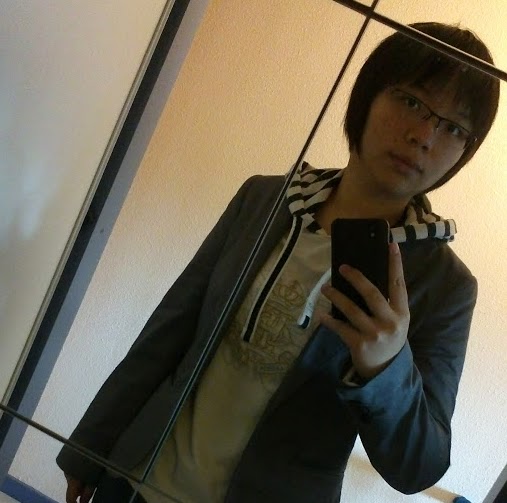Jingyi Li
age ~49
from Chicago, IL
Jingyi Li Phones & Addresses
- Chicago, IL
- Charlottesville, VA
Resumes

Research Assistant At University Of Virginia
view sourceLocation:
Charlottesville, Virginia Area
Industry:
Biotechnology

Senior Scientist
view sourceLocation:
Charlottesville, VA
Industry:
Biotechnology
Work:
Scientific Journal of Frontier Chemical Development since Feb 2013
Editorial board member
MicroLab Horizon - Charlottesville, Virginia Area since Aug 2012
Scientist
University of Virginia Jun 2009 - Aug 2012
Graduate Research Assistant
University of Virginia Sep 2008 - May 2009
Graduate Teaching Assistant
University of Minnesota Sep 2006 - May 2008
Graduate Teaching Assistant
Editorial board member
MicroLab Horizon - Charlottesville, Virginia Area since Aug 2012
Scientist
University of Virginia Jun 2009 - Aug 2012
Graduate Research Assistant
University of Virginia Sep 2008 - May 2009
Graduate Teaching Assistant
University of Minnesota Sep 2006 - May 2008
Graduate Teaching Assistant
Education:
University of Virginia 2008 - 2012
Doctor of Philosophy (Ph.D.), Analytical Chemistry University of Minnesota-Twin Cities 2006 - 2008
Master of Science (M.S.), Materials Chemistry Tianjin University 2002 - 2006
Bachelor of Science (B.S.), Chemistry
Doctor of Philosophy (Ph.D.), Analytical Chemistry University of Minnesota-Twin Cities 2006 - 2008
Master of Science (M.S.), Materials Chemistry Tianjin University 2002 - 2006
Bachelor of Science (B.S.), Chemistry
Skills:
Chemistry
Biotechnology
Analytical Chemistry
Mass Spectrometry
Organic Chemistry
Microfluidics
Materials Science
Laboratory
Nmr
Pcr
Uv/Vis
Nanotechnology
Xps
Genetics
Assay Development
Uv/Vis Spectroscopy
Surface Chemistry
Mathematica
Image Analysis
Electrophoresis
Dna Extraction
Polymerase Chain Reaction
Laboratory Skills
Statistical Data Analysis
Fluorescence Microscopy
Purification
Fluorescence
Research
Science
Biotechnology
Analytical Chemistry
Mass Spectrometry
Organic Chemistry
Microfluidics
Materials Science
Laboratory
Nmr
Pcr
Uv/Vis
Nanotechnology
Xps
Genetics
Assay Development
Uv/Vis Spectroscopy
Surface Chemistry
Mathematica
Image Analysis
Electrophoresis
Dna Extraction
Polymerase Chain Reaction
Laboratory Skills
Statistical Data Analysis
Fluorescence Microscopy
Purification
Fluorescence
Research
Science
Interests:
Microarray
Entrepreneurship
Microfluidics
Biotechnology
New Technologies
Photography
Sports
Chemistry
Entrepreneurship
Microfluidics
Biotechnology
New Technologies
Photography
Sports
Chemistry
Languages:
English
Mandarin
Mandarin

Senior Scientist
view sourceLocation:
Chicago, IL
Industry:
Pharmaceuticals
Work:
Hospira
Senior Scientist
Pfizer
Senior Scientist
Innopharma Jan 2011 - Sep 2014
Research Scientist
Celgene Coporation Apr 2002 - Jul 2009
Senior Research Scientist
Celgene Coporation May 1998 - Apr 2002
Research Scientist
Senior Scientist
Pfizer
Senior Scientist
Innopharma Jan 2011 - Sep 2014
Research Scientist
Celgene Coporation Apr 2002 - Jul 2009
Senior Research Scientist
Celgene Coporation May 1998 - Apr 2002
Research Scientist
Education:
University of Alberta 1991 - 1995
Doctorates, Doctor of Philosophy, Philosophy, Chemistry Shandong Medical University
Masters, Chemistry Shandong University, China
Bachelors, Chemistry
Doctorates, Doctor of Philosophy, Philosophy, Chemistry Shandong Medical University
Masters, Chemistry Shandong University, China
Bachelors, Chemistry

Master Of Science In Finance
view sourceLocation:
Chicago, IL
Industry:
Financial Services
Work:
Junior Achievement of Chicago
Volunteer
Loyola University Chicago
Master of Science In Finance
Harding University Aug 2009 - May 2014
Student
Volunteer
Loyola University Chicago
Master of Science In Finance
Harding University Aug 2009 - May 2014
Student
Education:
Loyola University Chicago 2014 - 2016
Master of Business Administration, Masters, Finance Harding University 2009 - 2014
Bachelors, Finance
Master of Business Administration, Masters, Finance Harding University 2009 - 2014
Bachelors, Finance
Skills:
Powerpoint
Microsoft Word
Vba
R Language
Eviews
Stata
Cfa Level 2 Candidate
Microsoft Word
Vba
R Language
Eviews
Stata
Cfa Level 2 Candidate
Interests:
Human Rights
Economic Empowerment
Economic Empowerment
Certifications:
Cfa Level 2 Candidate
Bat Test 74Th Pctl
Bat Test 74Th Pctl

Jingyi Li
view source
Jingyi Li
view source
Jingyi Li
view sourceLocation:
Chicago, IL
Us Patents
-
Method For Detecting Nucleic Acids Based On Aggregate Formation
view source -
US Patent:20130203045, Aug 8, 2013
-
Filed:May 26, 2011
-
Appl. No.:13/699983
-
Inventors:James P. Landers - Charlottesville VA, US
Kimberly A. Kelly - Crozet VA, US
Jingyi Li - Charlottesville VA, US
Daniel C. Leslie - Brookline MA, US -
Assignee:University of Virginia Patent Foundation - Charlottesville VA
-
International Classification:C12Q 1/68
C12Q 1/70 -
US Classification:435 5, 435 612, 435 61, 435 611
-
Abstract:The invention provides methods to detect or determine the presence or amount of a pathogen, such as a virus or bacterium, in a sample or the amount of cells based on the detection of their genomic DNA. The method employs magnetic substrates and subjects the sample and the magnetic substrate to forms of energy so as to induce aggregate formation and detects the aggregates.
-
Method For Detecting Nucleated Cells
view source -
US Patent:20120149587, Jun 14, 2012
-
Filed:May 26, 2011
-
Appl. No.:13/116659
-
Inventors:James P. Landers - Charlottesville VA, US
Jingyi Li - Charlottesville VA, US
Daniel C. Leslie - Brookline MA, US -
Assignee:University of Virginia Patent Foundation - Charlottesville VA
-
International Classification:C40B 30/00
C12Q 1/68 -
US Classification:506 7, 435 61, 435 612
-
Abstract:The invention provides methods to detect or quantify cells such as nucleated cells in a sample such as a physiological sample, which employ magnetic substrates and subjects the sample and the magnetic substrate to forms of energy so as to induce aggregate formation.
-
Method And System For Sample Collection, Storage, Preparation And Detection
view source -
US Patent:20230072999, Mar 9, 2023
-
Filed:Aug 5, 2022
-
Appl. No.:17/881802
-
Inventors:- Southampton, GB
Christopher Birch - Charlottesville VA, US
Daniel Mills - Charlottesville VA, US
Brian Root - Charlottesville VA, US
James Landers - Charlottesville VA, US
Jingyi Li - Charlottesville VA, US
Matthew Yeung - Mount Waverley, AU
David Saul - Dunedin, AU
David Vigil - Mount Waverley, AU
Andrew Guy - Mount Waverley, AU
Stan Wada - Mount Waverley, AU
Betina De Gorordo - Mount Waverley, AU
Steward Dodman - Mount Waverley, AU
Tom Moran - Southampton, GB
Stuart Knowles - Mount Waverley, AU
Fernando Dias - Mount Waverley, AU
Rick Gardner - Mount Waverley, AU -
International Classification:B01L 3/00
G01N 33/569
G01N 33/543
G01N 1/18
G01N 1/40
B01L 7/00 -
Abstract:A collection device for a biological sample to capture target compounds such as viruses or other pathogens or particles for testing from within the sample and move the captured target compound to a separate chamber for subsequent processing. The collection device can include an openable substance blister including capture particles located in a cup interior. Capture particles can attract and bind the target compounds from the sample. An extraction tube extracts any nucleic acid from the target compound for storage or subsequent amplification and testing to confirm presence of known microorganisms. The extraction tube can comprise a heat-deformable material and can be connected to a microfluidic cartridge for further processing of nucleic acid including, amplification and detection. The microfluidic cartridge includes valves and a plurality of chambers for amplification.
-
Devices, Systems And Methods For Sample Detection
view source -
US Patent:20190054468, Feb 21, 2019
-
Filed:Oct 21, 2016
-
Appl. No.:15/770413
-
Inventors:- Charlottesville VA, US
Kimberly Renee JACKSON - Atlanta GA, US
Daniel MILLS - Charlottesville VA, US
Gavin T. GARNER - Charlottesville VA, US
Jacquelyn A. DuVall - Raleigh NC, US
Jingyi LI - Charlottesville VA, US -
International Classification:B01L 3/00
C12Q 1/6809
C12Q 1/6816
C12Q 1/6827
G01N 33/52
G01N 33/543
G01N 33/68
G01N 35/00 -
Abstract:This disclosure provides for apparatuses, systems and methods for in vitro sample detection. For example in one embodiment, this disclosure provides an automated Pe-toner microfluidic device (and related method) on a centrifugal platform for DNA sample lysis and DNA extraction. A second embodiment provides a system and method for qualitative detection, quantification, and real-time monitoring of nucleic acid amplification products using magnetic bead aggregation inhibition. A third embodiment provides a platform for simultaneous detection of mRNA markers from blood, cell-free semen, sperm, saliva, and vaginal fluid. The third embodiment comprises a system and method that provide for simple, rapid, and fluorescence-free detection of body fluids using mRNA marker amplification and optical detection for mRNA marker analysis with a smart phone with image analysis.
-
Devices And Methods For Extraction, Separation And Thermocycling
view source -
US Patent:20180304253, Oct 25, 2018
-
Filed:Oct 13, 2016
-
Appl. No.:15/768115
-
Inventors:- Charlottesville VA, US
Jacquelyn A. DuVall - Raleigh NC, US
Delphine Le Roux - Barboursville VA, US
Brian Root - Charlottesville VA, US
Daniel MIlls - Charlottesville VA, US
Daniel A. Nelson - Charlottesville VA, US
An-chi Tsuei - Charlottesville VA, US
Brandon L. Thompson - Charlottesville VA, US
Jingyi Li - Charlottesville VA, US
Christopher Birch - Charlottesville VA, US -
International Classification:B01L 3/00
B01L 7/00
G01N 27/447 -
Abstract:A method to extract, amplify and separate nucleic acid in a microfluidic device having a plurality of chambers and channels can include a) introducing cells having nucleic acid to a first chamber of the microfluidic device and subjecting the cells in the first chamber to conditions that lyse the cells. The method can further include b) subjecting the first chamber to centrifugal force, thereby allowing the lysate or a portion thereof having nucleic acid to be distributed to a second chamber through a first channel in the microfluidic device. The method can also include c) combining the lysate or the portion thereof and reagents for amplification of the nucleic acid, thereby providing a second mixture. The method can also include d) subjecting the second chamber to centrifugal force, thereby allowing gas to be expelled from the second mixture.
-
Microfluidic Valve Systems
view source -
US Patent:20150093838, Apr 2, 2015
-
Filed:Oct 1, 2014
-
Appl. No.:14/503955
-
Inventors:James P. Landers - Charlottesville VA, US
Yiwen Ouyang - Charlottesville VA, US
Jingyi Li - Charlottesville VA, US -
International Classification:B01L 3/00
B32B 38/00
B32B 38/10
B32B 37/18 -
US Classification:436180, 422503, 156182
-
Abstract:A microfluidic device having a chip defining fluid channels and having toner patches printed within the channels. The toner patches are printed with hydrophobic toner to apply inertial pressure to fluids travelling through the channels. The density of hydrophobic toner and the dimensions of the toner patch can be varied to alter the inertial pressure applied to the fluid. The chip can be rotated about a rotational axis to apply external pressure to fluids sufficient to overcome the inertial pressure created by the toner patch to push fluid past the toner patch. The rotational speed of the chip can be varied to facilitate movement of fluid through the channels and to push fluid past the hydrophobic toner patches.
Medicine Doctors

Jingyi Li
view sourceGoogleplus

Jingyi Li

Jingyi Li

Jingyi Li

Jingyi Li

Jingyi Li

Jingyi Li

Jingyi Li

Jingyi Li

Jingyi Li
view source
Jingyi Li
view source
Jingyi Li
view source
Jingyi Li
view source
(Jingyi Li)
view source
Jingyi Li
view source
Jingyi Li
view source
Jingyi Li
view sourcePlaxo

Li, Jingyi
view sourceYoutube
Flickr
Get Report for Jingyi Li from Chicago, IL, age ~49










